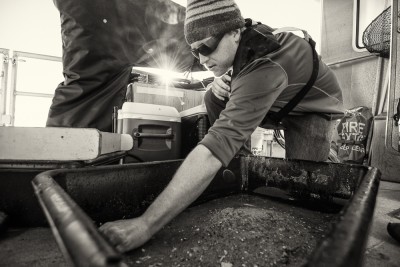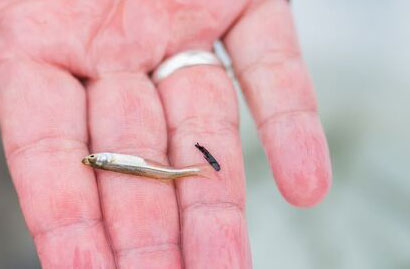
[Lab news] Jake participates in the fall 2016 Massachusetts Bottom Trawl Survey


The Ocean & Atmospheric Research program (OAR) of NOAA and Sea Grant just announced the winners of its most recent round of research funding to better understand the consequences of ocean warming and acidification on key marine resources in U.S. Northeast coastal waters. We are happy and proud that our proposed work on the climate sensitivity of Northern sand lance (Ammodytes dubius) was one of the four projects selected for funding. This is particularly good news for Chris Murray, who for his PhD can now expand his experimental rearing expertise to this important species.
This work will be conducted collaboratively with colleagues from NOAA (David Wiley), USGS (Page Valentine), Boston University (Les Kaufman), and Woods Hole Oceanographic Institution (Scott Gallager).
You can read the official announcement as it appeared on 6 September 2016 on NOAA’s News site.

On 19-20 July, our lab temporarily transformed into a genetics laboratory, as Nina Therkildsen and her post-doc Aryn Pierce Wilder visited us from Cornell University (Therkildsen Lab). Their lab also shares the fascination for the Atlantic silverside as a model organism and has set out to eventually assemble the fully annotated genome of this species.
During their visit, they could accompany us for our bi-weekly beach seining in Mumford Cove, where we collected juveniles born this year as well as the last few spawning ripe adults at the end of the season. It was a great summer morning and fun for everyone.
In the lab, Nina and Aryn went on dissecting different types of tissue (muscle, liver, spleen, gills, fins) from a few specimens destined for genetic analyses. In the Rankin lab, we tried a novel procedure on this species, i.e., making haploid embryos by fertilizing strip-spawned eggs with sperm that was UV-radiated before.
Thank you for visiting, Nina and Aryn, and we will see you back in fall, when Nina will give a Friday seminar on 11 November 2016. We’re looking forward to what she will have to report!



On 6 June 2016, Charlie, Jake and Hannes set course again to the nearby Mumford Cove to retrieve our pH/oxygen/temperature probe (Eureka Manta Sub2) after over six weeks of deployment. Thanks to a newly purchased larger battery-pack that extend the probe-life to more than twice its previous time, the probe continuously recorded conditions every 30 minutes, thereby extending our time series to now over 14 months.
Plus, it was a great, balmy day on the water, and working in the field beats the desk hands down 😉
Check out a selection of the great pics Jake took during the trip below:
The information material below contains graphical summaries of our activities, i.e., measuring water quality parameters continuously with a logging probe and conducting biweekly beach seine surveys for silversides.
To a productive year 2016 in the cove!
Roughly once a month, somebody from our lab has to hop on a small institute boat and drive the 20 min over to our local field site, Mumford Cove, to exchange the sensors on our monitoring buoy. Depending on water temperature, the Eureka Probes recording temperature, salinity, pH, and oxygen in 30 min intervals are getting exchanged with another newly calibrated one with a fresh set of batteries.
As usual, Jake’s seeing this a great occasion to bring his GoPro along and have a new underwater look at the cove. What’s interesting, the dense seagrass meadows that cover the Cove’s bottom have become spotty this time of the year, and there’s much more sand visible.
We are happy to announce the continued support of the National Science Foundation, Division of Biological Oceanography, which just started to fund our project about multi-stressor effects on the early life stages of fish. This is collaborative work with Prof. Janet Nye’s lab at Stony Brook University, NY, which will strengthen ties between UConn and Stony Brook Marine Sciences. The work has already started and we’re looking forward to new discoveries!
Baumann, H. and Nye, J. 2015. Collaborative research: Understanding the effects of acidification and hypoxia within and across generations in a coastal marine fish. NSF Project# 1536336 (3 years)
Learn more by accessing the NSF-OCE non-technical proposal abstract

By Jacob Snyder:
Chris and I meet up, grab the supplies we need (buckets, bags, coolers, aerators, etcetera), and start making our way to Scituate, Mass. Today we are going out on the NOAA vessel “Auk,” with a few members from NOAA and the USGS. Our goal? To collect approx. 200 Northern Sand Lance, Ammodytes dubius.We boarded the ship …
Read the whole post and see all the pictures on Jake’s blog @ Red Skies Photography
Check out the footage from the day, thanks to Jake and his GoPro. Check-out the video from the second sampling trip about one month later, too!
Golden fall morning at Mumford Cove. Picture-book conditions for beach seining with graduate and undergraduate students. Have a look for yourself (Picture credit: Sean Flynn, 9 Oct 2015)